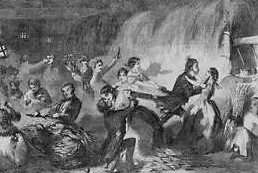Communal projects were often social occasions, as a settler described in later years. In the early settlement of the country, there were cabin and barn raisings, log-rollings, wood-choppings, corn-huskings, and sewing and quilting parties, and at such gatherings, utility and amusements were usually blended. Rich and poor then met upon lines of social equality, and the old and young mingled together in those old-time gatherings.
The Pioneers were helpful to each other, not only in “raisings” and “rollings,” requiring a force of men, but also in other ways. If a settler was incapacitated from work by sickness or other cause, his neighbors set a day and gathered in force and plowed his corn, harvested his grain, or cut his wood for the winter, as the season or occasion required. And when a pig or a calf or a sheep was killed, a piece of the same was sent to the several families in the neighborhood, each of whom reciprocated in kind, and in this neighborly way all had fresh meats the greater part of the summer.

Corn Husking – Finding the Red Ear. New England 1820
Corn-huskings were great occasions. Sometimes the corn ears were stripped from the stalks and hauled to a favorable place and put in parallel or semi-circular windrows, convenient for the huskers. Moonlight nights were usually chosen for husking-bees, and sometimes bonfire lights were improvised. After the company gathered, captains were selected who chose the men off into two squads or platoons which competed in the work, each trying to finish its row first. The captain of the winning squad would then be carried around on the shoulders of his men, amid their triumphal cheer, and then the bottle would be passed.
Women also attended these Pioneer gatherings and sometimes assisted at the husking, but more frequently were engaged in the early evening in quilting or sewing, or in helping to prepare the great supper-feast that was served after the work was done.
There was a rule that a young man could kiss a girl for each red ear of corn found at a husking, and it goes without the saying that all the girls were kissed, some of them several times for it was surprising how many red ears were found – so many that the number was prima facie evidence that some of the boys went to the huskings with their pockets full of red corn ears.
Nearly all the Pioneer gatherings wound up after supper with a dance. When a fiddler could not be obtained, music for the occasion was furnished by some one blowing on a leaf, or by whistling “dancing tunes.” The dancing was more robust in those days than artistic, perhaps, for the people were robust in those days, effeminacy not becoming fashionable until later years. [1]
Clothing was precious in the early years of settlement. The clothing brought from the East soon wore out, especially for the men, who worked clearing the land and planting the fields. It would be several years before replacement clothing would be readily available. Raccoon and muskrat caps, and deerskin jackets and pantaloons, were for several years . . . the leading articles of dress. This style of clothing was not as practical as it may seem, and resulted in many ludicrous incidents . . . from the dryings, or freezing, of this very changeable and unaccommodating species of apparel. [2]
As the settlers tamed the frontier, they introduced sheep and began to use wool to make clothing. But before it could be used the wool had to be carded into rolls by hand, and after the rolls had been spun into yarn and the yarn woven into flannel, the product of the loom had to be “fulled” into thicker cloth for men’s wear. As this was a hand or rather a foot process, it necessitated “fulling” or “kicking” parties. Upon such occasions the web was stretched out loosely on the puncheon floor and held at each end, while men with bared feet sat in rows at the sides and kicked the cloth, while the women poured on warm soapsuds, and the white foam of the suds would often be thrown over both the kickers and attendants. [3]
Pioneer gatherings in those days had two purposes, to accomplish work that families couldn’t do on their own and as an opportunity to socialize and meet new friends. Young people found romance at these gatherings, and no doubt, Clarissa Benedict had her fair share of suitors.
Please like this post and let me know what you think in the comments. Thank you.
GO TO NEXT POST – Clarissa Benedict
Footnotes:
[1] “Pioneer Gatherings” by A.J. Baughman, The Firelands Pioneer, December 1900, pp. 629-630.
[2] Description of wardrobes of men in the early days of settlement is from “Oration of Eleutherous Cooke,” The Firelands Pioneer, June, 1858, p. 6
[3] “Pioneer Gatherings” by A.J. Baughman, The Firelands Pioneer, December 1900, pp. 629-630.
© 2009 by David W. Barton. All rights reserved
Filed under: Frontier Life, Ohio | Tagged: Frontier Life, Ohio History |


[…] log-rollings, wood-choppings, corn-huskings, and sewing and quilting parties, as I described in the “Social Life on the Frontier” post of the “Sufferers’ Land” series on this […]
LikeLike